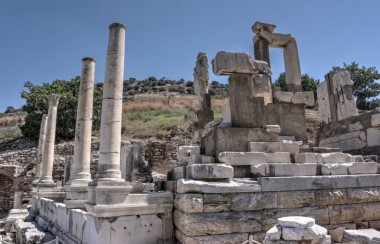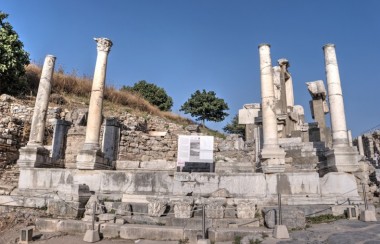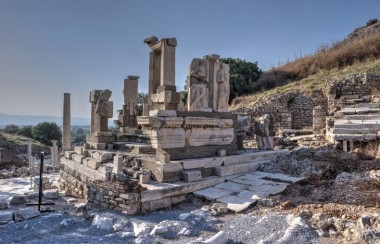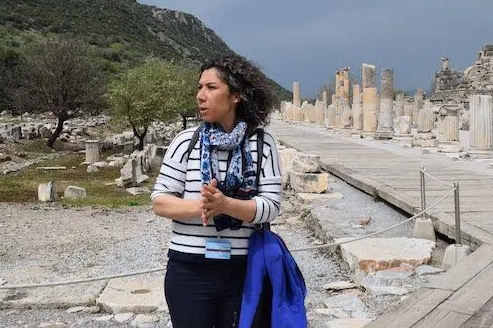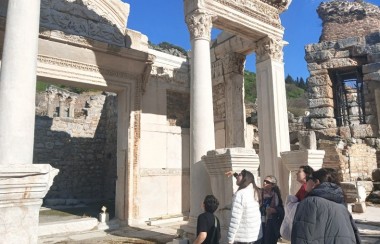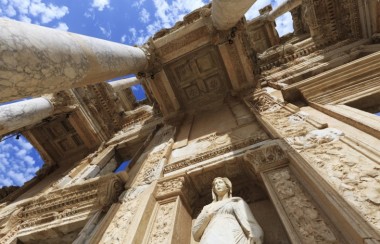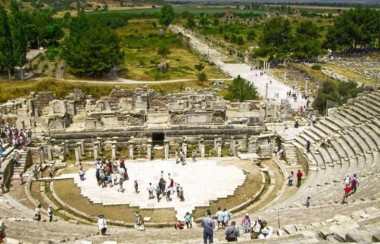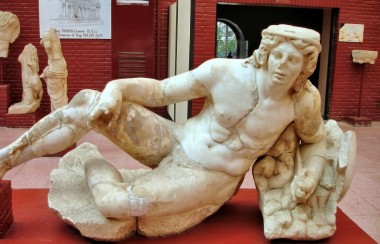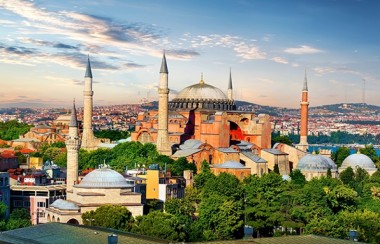The remains of the impressive fountain known as the Hydreion occupy a space near the intersection of the Curetes Street and the so-called Terrace House Street. This street covered the upper storeys of the Terrace Houses, and it got down and reached the main artery of Curetes Street just at the fountain.
Two water basins have been preserved, flanked by a semi-circular niche that was originally adorned with many statues. The building inscription informs us that T. Flavius Meander was its founder, during the Severan period, i.e. around 200 CE. However, the reused architectural fragments suggest that there had been an earlier monument in the same location, dating back to the early Imperial period, possibly to the times of Octavian Augustus.
The monument was modified in the late antiquity when the statues of the Tetrarchs, — Diocletian, Maximian, Galerius, and Constantius Chlorus — were installed in front of the fountain, similarly as was the case in the so-called Temple of Hadrian. Four Corinthian columns that supported these statues have been re-erected. There are also indications that the fountain itself was repaired in the 4th century CE.
It is believed that the Hydreion served more than just a decorative purpose. With a large amount of traffic along the Curetes Street, the water was used to keep the street clean and to keep the marble surface wet during the hot summer months. The area at the Memmius Monument and the Hydreion also created a small square where the people walking along the Curetes Street could rest for a while in the shade. One can imagine the weary travellers sitting there, gazing up the Curetes Street and listening to the sound of flowing water.
The monument behind the Hydreion, on the other hand, served a more dignified purpose by reminding the citizens of Ephesus of some grim events from the city's past. The Memmius Monument was a memorial built during the reign of Octavian Augustus. The inscription of the monument referred to Sulla's capture of the city after the Mithridatic Wars in the 1st century BCE. The inscription also informs that the statue of Lucius Cornelius Sulla once stood on the base built of stone blocks.
The founder of the monument, Gaius Memmius, was the son of Gaius Memmius and Fausta Cornelia, the daughter of Lucius Cornelius Sulla. Thus, he was a grandson of Sulla, the former dictator of Rome. However, very little is known of Gaius Memmius' career. He served as consul suffectus in 34 BCE and was later appointed to the position of a proconsular governor of Asia, sometime after 30 BCE.
He erected the so-called Memmius Monument to honour himself and three generations of his family. The inscription reads "To Gaius Memmius, son of Gaius Memmius, grandson of Sulla Felix (paid for this monument) from his own funds." The monument originally had a form of a four-sided victory arch, and there were three sets of stairs between the columns holding an arch. The memorial had four facades depicting Sulla's army and the reliefs symbolizing the virtues of the dictator. Sulla, his son Gaius Memmius, and his grandson (also Gaius Memmius) are depicted on the reliefs of this monument of ancestral glory.
Related Shore Excursions
Explore Ephesus History with our Shore Excursions .
Secrets Of Ionia
Miletus which was a great Ionian Port, with two lions guarding its entrance and the theater, reconst...
Ultimate Ephesus
Terrace Houses: Admire the frescoed walls, mosaic flooring and peristyle courtyards of homes where E...
Archaeological Ephesus Tour
Majestic Ephesus takes you on an unforgettable journey through history; etched on minds as the...
Discover The Magic Of Ephesus
Majestic Ephesus takes you on an unforgettable journey through history; etched on minds as the...
Roman Heritage & Ottoman Marvels
Blue Mosque, Byzantine Hippodrome, Hagia Sophia, Mevlana Bazaar, Topkapi Palace

